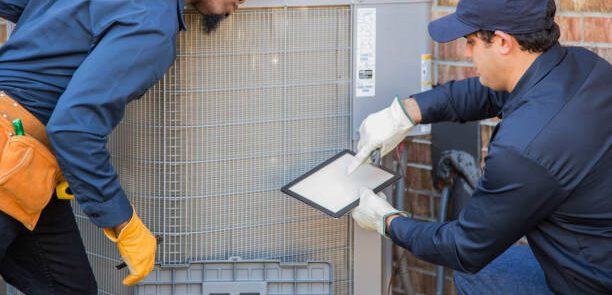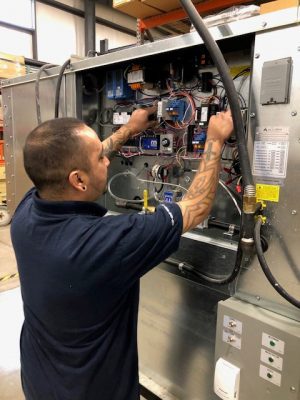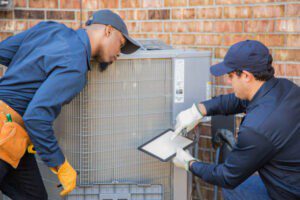If you’re looking to take matters into your own hands and do our environment some good while saving money, you aren’t alone. Across the nation, tens of thousands of households are doing the exact same thing – cutting back on their carbon output for the sake the planet. While the number of ways you can cut down on your carbon emissions is huge, one of the single biggest carbon emitters in your home is likely your heating and cooling system.
Drawing power 24/7, your HVAC unit may be one of the largest contributors to your carbon footprint – especially in the hotter months, when it’s working at full capacity. Cutting down on the power it draws is one huge step toward a smaller footprint, and to help you toward that goal, we’ve compiled a brief list of 5 ways you can shrink your carbon footprint this summer.
Make Your House Shadier
It’s no secret that the sun just seems hotter in the summer months, but it’s still easy to underestimate just how good the sun is at heating up surfaces. We’ve all heard horror stories of pets and people getting burns from 130° sidewalks, but it’s worth keeping in mind that the same sunlight that superheats your driveway can heat up your whole house just as easily.
The best way to stop the sun from baking your interiors is to prevent sunlight from reaching your indoor spaces. Installing some shades, especially in rooms that see little traffic, is a great way to keep the sunlight out and keep those rooms cool. That isn’t to suggest you need blackout curtains in every room, but keeping some rooms, like the laundry room, basement or empty guest bedroom, out of the sun can majorly cut down on your summer electricity bill.
Or, for a longer-term solution, consider looking to nature. Planting some tall and/or leafy plants around your house, namely trees, can greatly shade your home, acting as a sort of natural umbrella. Not to mention, the climate always benefits from the planting of more trees.
Blow A Nice Breeze In Through Home
Nothing is better on a hot summer’s day than a cool breeze, no matter if you’re outside or in. Switching in part to a fan to help cool your home can be an effective way to keep your rooms cool- instead of having your HVAC unit do more lifting than it may need to, supplement it with some fans.
Fans are an often underestimated way to cool your space. A small floor fan alone can lower the perceived temperature in a given room by as much as 4°, which can result in large reductions in HVAC usage, and therefore power consumption, over time. Setting up a fan in your living room, flicking the switch on the ceiling fan in your bedroom, or even plugging in a desk fan when you’re working in your home office, can go a long way in reducing your home’s carbon emissions.
Touch Up Your Home’s Insulation
Your home’s insulation doesn’t just keep heat in in winter time – it keeps it out in summer time. Just like holes in your insulation can make your home frigid in the winter, it can make your home much hotter than it needs to be come summer – and the solution is the same no matter the season.
Patching those holes in your home’s insulation can make your home much more energy-efficient, saving you money and shrinking your footprint. If you feel heat seeping in through a window, for instance, it may be time to re-seal them. Proper insulation will not only help out tremendously in the summer, but will also help out in the winter just as much. New insulation in your home makes for a solid investment in your home, your wallet, and the environment all the same.
Be Wise When It Comes To Your Thermostat
It’s true that AC is invaluable when temperatures outside rise, but how low does your thermostat need to go to make your home comfortable? If your’s is currently sitting at 70°, 68° or even lower, your HVAC may be working much harder than it needs to to make your home livable. The difference only a few degrees makes in your HVAC unit’s energy consumption is bigger than many people recognize, so it may be smart to give it a break.
Tuning your thermostat to something closer to 72° or 74° will provide you with a comparable feel to lower temperatures, while saving considerably on money and emissions in the process. Combine this with the aforementioned fans or shade, and your home will feel just as it was, but with more money in your wallet and a healthier environment to show for it.
Service/Upgrade Your HVAC Unit
Over time, your heating and cooling system starts running below peak efficiency. This happens to all HVAC systems, and is a result of many factors – clogged vents, coolant leaks, old or worn components, among other things. These inefficiencies mean your HVAC needs to work a lot harder than it used to to achieve the same level of cooling, which increases the amount of power it draws considerably.
To get the most out of your heating and cooling system, you need the help of an AC professional. An HVAC contractor like Rogers & Sons, Inc. can get your HVAC unit back in shape, and put a stop to the unnecessary power hogging that your AC is doing this season.
In many cases older AC units might not have the efficiency potential that newer units have regardless of how well you have kept up with the maintenance. In these cases, Rogers and Sons can help you determine the right energy-efficient unit for your space so you can reap the benefits of today’s technology saving money and reducing your carbon footprint.
If your HVAC hasn’t been serviced in years, or needs to be replaced, it’s time to get in touch with a HVAC expert. Give us a call or get in touch online to see what Rogers & Sons can do for you.




